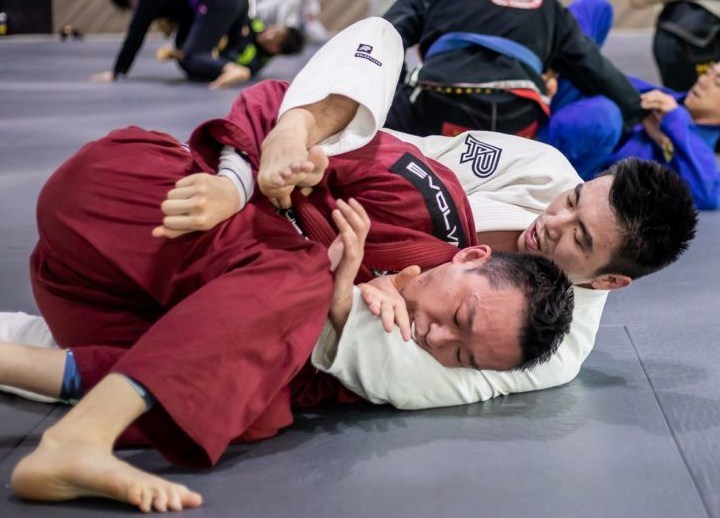Guest post by Evolve MMA, Asia’s premier championship brand for martial arts. It has the most number of World Champions on the planet. Named as the #1 ranked martial arts organization in Asia by CNN, Yahoo! Sports, FOX Sports, Evolve MMA is the best Singapore BJJ gym.
Although submissions are part of what makes BJJ such an exciting and fun martial art, all white belts should focus a significant amount of their time on escapes. A BJJ practitioner who lacks the ability to escape bad positions will have a hard time progressing in the art. And although escapes may not seem as exciting as heel hooks and berimbolos, they can actually be a lot of fun, especially when you get good at them! In addition, once you’ve accumulated a solid arsenal of escapes, you’ll be much more comfortable attempting submissions. In this article, we examine 3 escapes every white belt should know.
Escape from mount
The mount is a position that white belts find themselves in often. This position involves one student sitting on his or her opponent’s chest with the knees pinched tightly against his or her sides. Needless to say, being stuck under a strong mount can be very uncomfortable. Therefore, it’s imperative to learn to escape from this position. The first mount escape white belts should learn is the trap and roll escape.
The Trap and Roll Escape
One of the most effective mount escapes for BJJ beginners is the trap and roll escape. The trap and roll escape is an excellent self-defense technique, and it is effective at all levels of BJJ competition. The escape works by trapping an opponent’s posting hand and foot. This removes his or her ability to place a hand or foot on the mat to prevent being rolled over. In order to perform the trap and roll escape, follow these steps:
(1) From bottom mount, using the hand that is closest to the side towards which you want to sweep your opponent, grip your opponent’s triceps.
(2) With your opponent’s triceps secured, grab the wrist of the same arm with your opposite hand, securing it firmly to your chest.
(3) On the same side as your opponent’s trapped arm, place your foot outside and against his or her foot, trapping the leg in place.
(4) Bridge your hips and roll in the direction of your opponent’s trapped arm and leg.
Escape the back mount
The back mount is considered by most to be the most dominant position in BJJ. In back mount, one student wraps his or her legs around an opponent’s waist. This is usually combined with an over/under grip, also known as a seatbelt grip. With a seatbelt grip, one arm is placed over the opponent’s shoulder, the other is placed under the opponent’s opposite armpit, and the hands are clasped in front of the opponent’s chest. The person trapped in back mount is vulnerable to a variety of chokes and submissions. Therefore, escaping the back mount is an important skill for white belts to master.
Bridge and Shrimp Escape
The shrimp, or hip escape, is a component of countless BJJ techniques. It also happens to be one of the best ways to escape bad positions. Similarly, the bridge is a common yet powerful BJJ movement. A back mount escape that all white belts should learn combines the bridge and the shrimp. In order to perform the bridge and shrimp back mount escape, follow these steps:
(1) With your opponent on your back, tuck your chin and place your hands in a “prayer” position inside your opponent’s seatbelt grip.
(2) Bridge your hips into the air.
(3) Look over the shoulder opposite your escaping side.
(4) Wiggle your shoulders towards the floor.
(5) As your back gets closer to the floor, grab and extend the pant leg of your opponent’s opposite leg to prevent him or her from following you.
(6) Place your back flat on the floor.
(7) With your back on the floor, shrimp away from your opponent. Be sure to push off of your opponent with your hands as you shrimp away.
(8) After successfully shrimping away, you may either spin towards your opponent and attempt to take the top position or remain on your back and establish a guard.
Escaping the Triangle Choke
Being caught in a triangle choke is a familiar feeling to most BJJ white belts, and let’s face it—it’s no fun. Having your opponent’s legs tighten around your neck as you struggle to break free is a horrible feeling. Luckily, there are quite a few effective triangle choke escapes out there.
The Elbow Down Escape
The first triangle choke escape that white belts should learn is the elbow down escape. The reason this escape is so effective is that it makes it hard for your opponent to exert the right amount of pressure on your neck to finish the choke. In order to perform the elbow down escape, follow these steps:
(1) After your opponent locks in a triangle choke around your arm and neck, place the elbow of your trapped arm firmly against his or her leg, thereby preventing your opponent from pulling your arm across your body. Be sure to protect your trapped arm as you do this—it’s a potential target for wrist locks and armbars.
(2) Move forward with your chest as if you are trying to walk through the center of your opponent’s triangle.
(3) As you move forward, pull back with your elbow against your opponent’s leg. When combined, these two movements place pressure on your opponent’s ankles, forcing him or her to open the triangle.
(4) With your opponent’s ankles now separated, walk your body in the opposite direction of your previously trapped arm. This will allow you to pass your opponent’s guard and establish side control.
Don’t Neglect Your Escapes
Remember, although escapes may not be as flashy as submissions, they are an extremely important part of BJJ. With a solid set of escapes in your BJJ arsenal, you won’t have to avoid trying new things out of fear of being caught in bad positions. Remember, the best offense is a good defense!




















